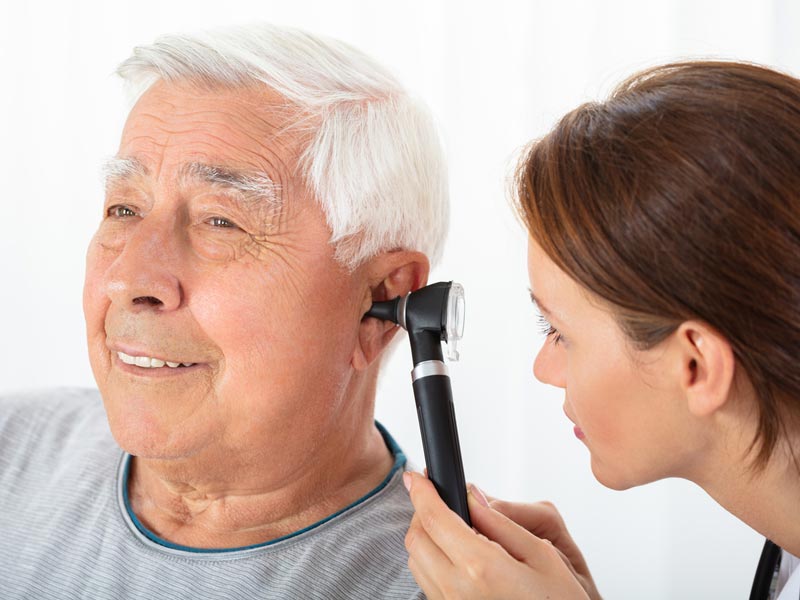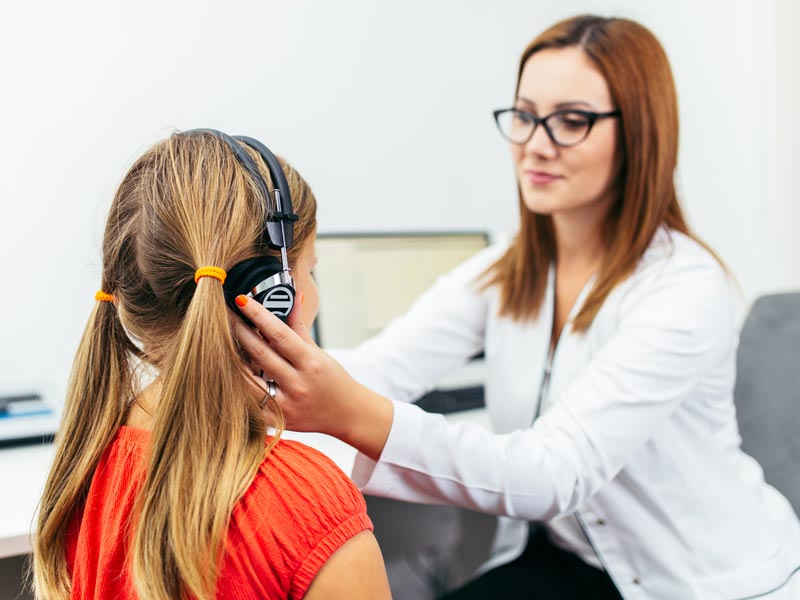At Queen City Ear Nose and Throat, we offer comprehensive evaluations and solutions for hearing loss conditions for patients of all ages. Whether you are a concerned parent who has recently identified a hearing condition in your child or a senior citizen with an existing hearing loss condition, we want to provide you with the best possible care.
Our mission to educate our patients on the impact of hearing loss on their overall health and quality of life. Well also aim to give them the best treatment options for their condition.
How We Hear:
Hearing begins at the outer ear, where sound waves are funneled into the ear canal until they reach the eardrum (tympanic membrane) and cause it to vibrate. This vibration travels through the three tiny bones (malleus, incus, and stapes) that occupy the middle ear space. These bones amplify and transfer the sound waves into the inner ear by moving the fluid and hair-like cells that reside within the hearing organ, known as the cochlea. The cochlea converts these sound waves into electrical impulses that the auditory nerve sends to the brain, which interprets them as sounds.
Understanding Hearing Loss:
There are three types of hearing loss: sensorineural, conductive, and mixed. During your comprehensive hearing test, our audiologists will be able to discover which type of hearing loss you have, which will help determine the best treatment options available for you.

Causes of SNHL:
- Normal aging (presbycusis)
- Extremely loud noise or prolonged noise exposure
- Infections (Mumps, Measles)
- Genetic syndrome
- Infection passed from a mother to a fetus in the womb (Rubella, Cytomegalovirus (CMV))
- Cardiovascular disease
- Side effects from certain medications
- Autoimmune disease
- Traumatic head injury
- Other diseases (Meniere’s disease, Acoustic Neuroma)

Symptoms of SNHL:
- Hearing someone speaking but not understanding what was said
- Noises may be too loud or too quiet
- Tinnitus (ringing in the ears)
- Trouble understanding speech in noisy environments
- Increased volume on the TV, when listening to music, or on the cell phone

Conductive Hearing Loss (CHL):
When hearing loss is due to damage or obstruction to the outer or middle ear, it is referred to as Conductive Hearing Loss (CHL). This condition prevents sound from reaching the cochlea. Conductive hearing loss can be either temporary or permanent, depending on the cause.
Causes of Conductive Hearing Loss:
• Wax (Cerumen) or foreign bodies in the ear canal
• Narrowing of the ear canal (stenosis)
• Middle ear infection (Otitis Media)
• Swimmer’s ear (Otitis Externa)
• Microtia
• Bone-like growth in the ear canal (exostosis)
• Perforation of the eardrum
• Abnormal growth or tumors in the middle ear space
• Ossicular chain discontinuity (break between the middle ear bone connections)

Symptoms of Conductive Hearing Loss:
• Unbalanced hearing (often affects only one ear)
• Pain and/or pressure in the ear canal
• Drainage in the ear canal
• Tinnitus (ringing in the ear)
• Feeling one’s voice is louder
• Increased volume on the TV, when listening to music, or on the cell phone

Mixed Hearing Loss:
Hearing loss is referred to as mixed when there are components of both SNHL and CHL. For example, someone with age-related SNHL may have an ear infection, creating a CHL component to their hearing loss. Causes and symptoms may be any combination of the two.

The Impact of Hearing Loss:
There have been studies linking untreated hearing loss to a higher risk of dementia and an overall decrease in cognitive function. Untreated hearing loss often leads to anxiety and depression, which can stem from the social withdrawal and isolation experienced by those with hearing loss.
Children with untreated hearing loss have a delay in the development of speech and language skills. They may not be able to clearly hear their parents, teachers, or classmates, which can cause them to fall behind their peers in academic performance, especially in reading and mathematical skills. They also may experience depression and isolation. See our article on Developmental Milestones for more information on this important topic.

Hearing Tests - What To Expect:
During your hearing test, you will be asked questions regarding your symptoms and concerns. Your ears will be visually inspected for signs of abnormalities, medical conditions, or ear wax. You will likely receive the following:
- A pressure test (tympanogram) to check the movement or flexibility of your eardrum and its ability to transmit sound,
- A tone test (audiogram) to measure how softly you can hear different pitches,
- And speech tests wherein a hearing specialist will ask you to repeat words to determine your ability to understand speech in different volumes.
The hearing test results will be charted and explained to you. Your audiologist will also provide you with hearing loss treatment options on the day of your hearing test.
Hearing loss is often progressive and can be hard to notice until you or a loved one develops signs of hearing loss. It is important to obtain a baseline hearing test and monitor changes over time to treat hearing loss as soon as possible. If you experience a sudden change in your hearing, seek medical attention as soon as possible from a knowledgeable provider. Getting a quick and accurate diagnosis and treatment can result in better outcomes.
If you or a family member have hearing loss, call Queen City Ear Nose and Throat at (704) 703-1080 or book an appointment online today.

